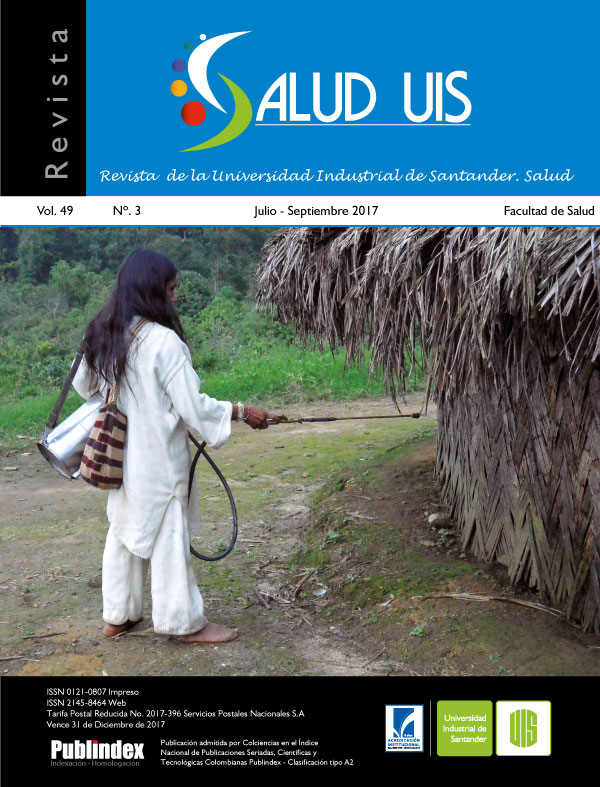Abstract
Introduction: Snakebites continue to be a public health problem, especially in tropical countries like Colombia. Objetive: To characterize the snakebite cases attended by a new poison center in Medellin, Colombia. Methodology: A descriptive, retrospective study was carried out, reviewing the information of the Center’s database from January 1st to December 31st , 2016. Results: There were 117 cases of ophidian accidents, affecting 93 men (79%) and 24 women (21%), with a median age of 32 years (range: 2 to 82 years). The follow-up of the cases could be done in 55 of the 117 accidents (47%), and complications were described in 18 of those 55 (33%) patients. The most commonly reported complication was a pruritic maculopapular rash that was associated to serum administration, without differences between the several brands of anti-ophidian serum used. The death of one patient (0.85%) was documented. The genus Bothrops caused most of the accidents. Discussion: Our results agree with previously published data.
Keywords: Snakebites, animals, poisonous,Colombia, serum sickness,toxicology.References
2. Gutiérrez JM, Williams D, Fan HW, Warrell DA. Snakebite envenoming from a global perspective: Towards an integrated approach. Toxicon. 2010; 56(7): 1223-1235. DOI: 10.1016/j.toxicon.2009.11.020.
3. Arnold BYC. The snakebite fight. Nature. 2016; 537: 6-8.
4. Instituto Nacional de Salud, Colombia. Informe del evento accidente ofídico hasta el periodo epidemiológico XIII, Instituto Nacional de Salud, Colombia 2016.
5. Harrison RA, Gutiérrez JM. Priority actions and progress to substantially and sustainably reduce the mortality, morbidity and socioeconomic burden of tropical snakebite. Toxins (Basel). 2016; 8(12): 351.
6. Cuesta J, Peña LM, Zuluaga AF. ¿Es necesaria la profilaxis antibiótica en la ofidiotoxicosis? Infectio. 2008; 12(1): 54-63.
7. Zuluaga AF, Rodriguez CA, Lastra-Bello S, Peña-Acevedo LM, Montoya-Giraldo MA. CIEMTO: the new drug and poison research and information center in Medellín, Colombia. Clin Toxicol (Phila). 2017; 13: 1-2. DOI: 10.1080/15563650.2017.1312003.
8. Leite RDS, Tamarys I, Targino G, Arianne Y, Ferreira C, Barros RM, et al. Epidemiology of snakebite accidents in the municipalities of the state of Paraíba, Brazil. Cien Saude Colet. 2013; 18(5): 1463-1471.
9. De Sousa L, Bastouri-Carrasco J, Matos M, Borges A, Bónoli S, Vásquez-Suárez A, et al. Epidemiología del ofidismo en Venezuela (1996-2004). Investig Clin. 2013; 54(2): 123-137.
10. Gutierrez JM. Envenenamientos por mordeduras de serpientes en América Latina y el Caribe: Una visión integral de carácter regional. Bol Mal Salud Amb. 2011; LI(1): 1-16.
11. Gutiérrez JM. Understanding and confronting snakebite envenoming: The harvest of cooperation. Toxicon. 2016; 109: 51-62.
12. Yañez-Arenas C, Yañez-Arenas A, Martínez-Ortiz D. Panorama epidemiológico de las mordeduras por serpiente venenosa en el estado de Yucatán, México (2003-2012). Gac Med Mex. 2016; 152(4): 568-574.
13. Vera, A.; Páez, M.; Gamarra de Cáceres, G. Caracterización Epidemiológica de los accidentes ofídicos, Paraguay 2004. Mem Inst Investig Cienc. Salud. 2006. 4(1): 20-24.
14. Rodríguez-Vargas AL. Comportamiento general de los accidentes provocados por animales venenosos en Colombia, 2006-2010. Rev Salud Pública. 2012. 14(6): 101-110.
15. Márquez Gómez MA, Gómez Díaz GM. Accidente ofídico en el departamento de Sucre, Colombia. NOVA. 2015; 13(24): 39-46.
16. Cubides S. Actitudes, creencias y prácticas desarrolladas en comunidades rurales del Urabá antioqueño con relación a las serpientes y su mordedura Municipio de Necoclí, Población Campesina y Comunidad Indígena Senú (Tesis de maestría). Universidad de Antioquia. Medellín, 2016.
17. Gutiérrez, J.M. Comprendiendo los venenos de serpientes: 50 años de investigaciones en América Latina. Rev Biol Trop. 2002; 50: 377-394.
18. Litovitz TL, Elshami JE. Poison center operations: The necessity of follow-up. Ann Emerg Med. 1982; 11(7): 348-352.
19. Mowry JB, Spyker DA, Brooks DE, Zimmerman A, L. SJ. 2015 Annual Report of the American Association of Poison Control Centers’ National Poison Data System (NPDS): 33rd Annual Report.ClinToxicol (Phila). 2016; 54(10): 924-1109.
Se autoriza la reproducción total o parcial de la obra para fines educativos, siempre y cuando se cite la fuente.
Esta obra está bajo una Licencia Creative Commons Atribución 4.0 Pública Internacional.
